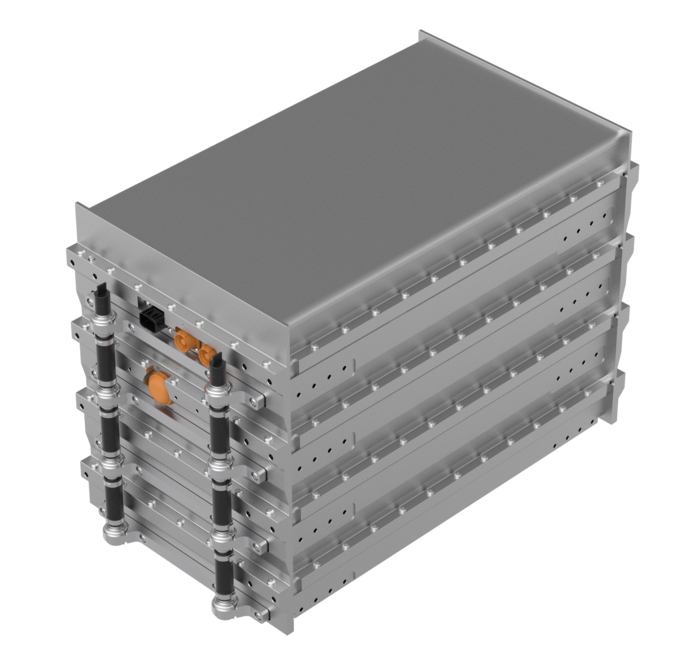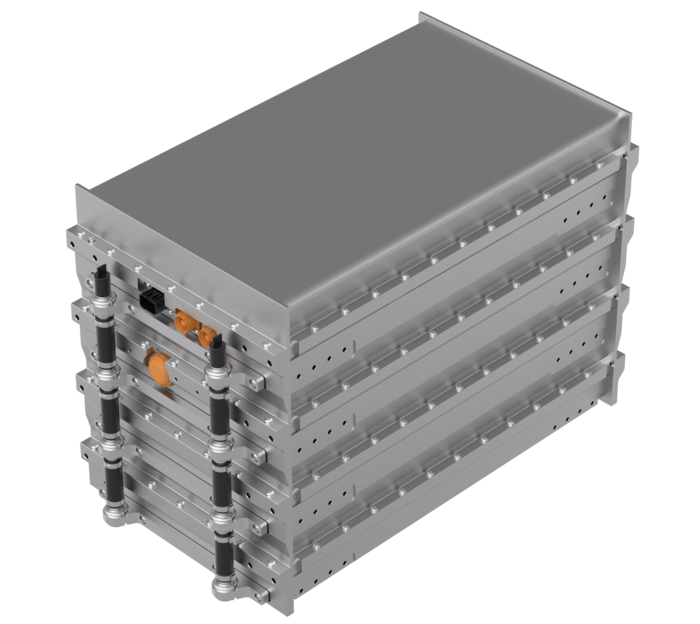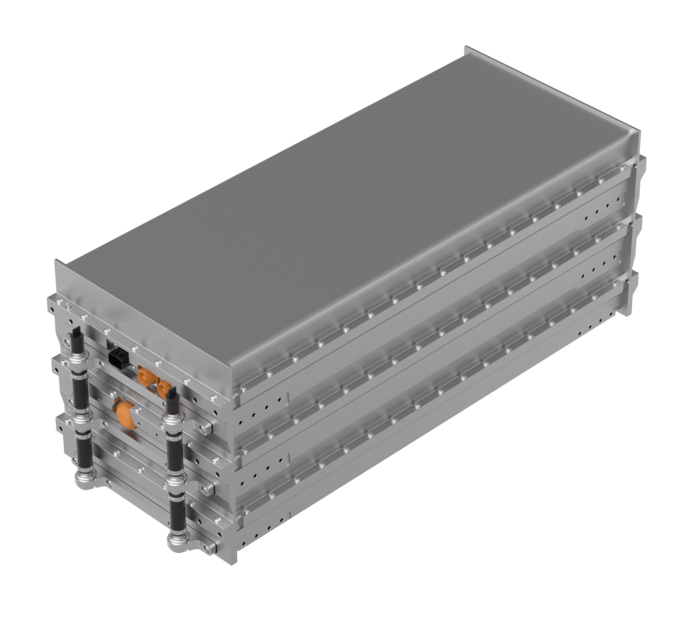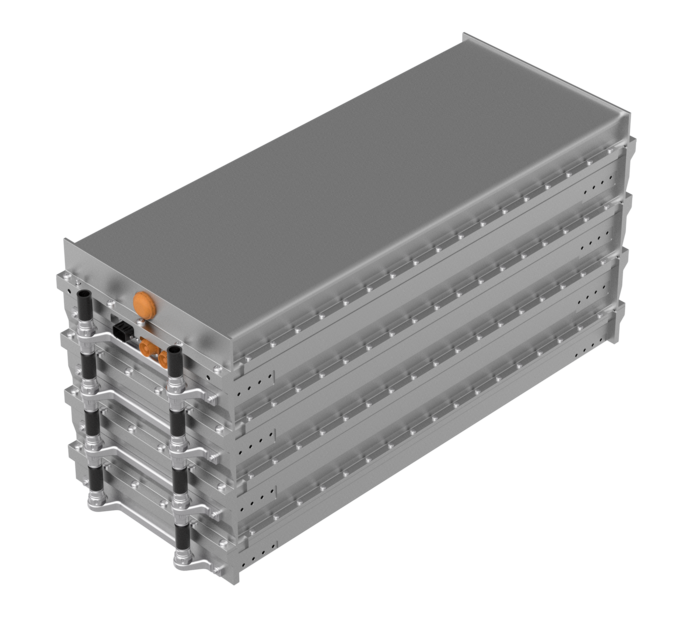
Reliable performance, maximum flexibility
DEUTZ HV Battery systems
The DEUTZ high performance batteries can be used in a wide range of applications and vehicles, especially designed for off-highway use, enabling the transition into a greener sustainable future.

SAFETY AND RELIABILITY FIRST AND FOREMOST
DEUTZ has developed a modular battery system that offers maximum flexibility in order to provide optimum performance for various off-highway applications and their requirements.
The DEUTZ HV battery systems are scalable in terms of dimensions and can implement a variety of voltage ranges and capacities to ensure optimum adaptation to the respective application.
Safety and reliability are top priorities at DEUTZ. The battery systems therefore features extensive safety measures in accordance with standards such as ECE R100, ISO 26262 and UN 38.3. These include a temperature and voltage monitoring system, an insulation monitor and various protective measures to ensure safe operation even in off-highway applications.
Remark: The batteries can be supplied as part of the DEUTZ E360 drive system and are also available individually for OEM drive systems. They can be installed without D-DEUTZ drive systems.
HIGH PERFORMANCE NMC BATTERY
- POWERFUL / Up to 400 V & 600 A
- SAFE / Highest Standard according ISO26262
- ROBUST / Designed for Off-Highway Applications
- COMPACT / Formfactor for engine compartments or narrow spaces
- FLEXIBLE / Parallel and serial connection
HIGH PERFORMANCE, OPTIMUM EFFICIENCY AND LONG SERVICE LIFE
DEUTZ uses lithium-ion cells for its specially developed 360V HV battery, which increases the total voltage to up to 360V by connecting 8 such modules in series.

E360 39 kWh
Compact high-power solution for integration in small engine compartments.

E360 41 kWh
Flat high-power solution in addition to higher 39 kWh Variant.

E360 59 kWh
Optimal energy density high-power variant for demanding energy or power use.
KEY FACTS AT A GLANCE
| E-DEUTZ High Voltage Battery | E360 41 kWh | E360 39 kWh | E360 59 kWh | |||
|---|---|---|---|---|---|---|
| System characteristics | ||||||
| Cooling | Water cooled with water/air heat exchanger | Water cooled with water/air heat exchanger | Water cooled with water/air heat exchanger | |||
| Battery type | Lithium-Ion (NMC) | Lithium-Ion (NMC) | Lithium-Ion (NMC) | |||
| Number of modules per battery | 16 | 15 | 23 | |||
| Number of cells per module | 12 | 12 | 12 | |||
| Nominal voltage | V | 358 | 355 | 343 | ||
| Voltage range | V | 300-403 | 303-377 | 310-385 | ||
| Energy (nominal value) | kWh | 41.5 | 38.8 | 59.2 | ||
| Energy (usable) | kWh | 36.7 | 34.7 | 53.3 | ||
| Continuous Charge | C (A) | 0.9 (106) | 0.9 (106) | 0.9 (158) | ||
| Maximum Charge | C (A) | 3.3 (384) | 3.3 (384) | 3.3 (576) | ||
| Continuous Discharge | C (A) | 1.5 (176) | 1.5 (176) | 1.5 (250) | ||
| Peak Discharge (10s) | C (A) | 5.2 (600) | 5.2 (600) | 3.5 (600) | ||
| Operating cell temperature | °C | -30 - +55 | -30 - +55 | -30 - +55 | ||
| Storage temperature | °C | -35 - +35 | -35 - +35 | -35 - +35 | ||
| Dimensions of housing (L x W x H) | mm | 1080x 440x 420 | 766x 440x 550 | 1080x 440x 550 | ||
| Volumetric energy density | Wh/l | 206 | 208 | 226 | ||
| Gravimetric energy density | Wh/kg | 142 | 140 | 146 | ||
| Weight (without mountings) | kg | 290 | 275 | 405 | ||
| IP protective class | IP67, IP6k9k | IP67, IP6k9k | IP67, IP6k9k | |||
| Standards | ||||||
| CE-Conformity | EU-Declaration of Conformity | EU-Declaration of Conformity | EU-Declaration of Conformity | |||
| Safety | EN 1175, EN 62619, EN 62485-6, EN 62620, ECE R 100 (Rev.2), ISO 26262, EN 60730-1 | EN 1175, EN 62619, EN 62485-6, EN 62620, ECE R 100 (Rev.2), ISO 26262, EN 60730-1 | EN 1175, EN 62619, EN 62485-6, EN 62620, ECE R 100 (Rev.2), ISO 26262, EN 60730-1 | |||
| Transport | EN 62281, UN 38.3 | EN 62281, UN 38.3 | EN 62281, UN 38.3 | |||
| EMC | ECE R 10, CISPR 25, EN 61000-6-2, ISO 11452, EN 12895, EN ISO 13766-1, EN ISO 13766-2, EN ISO 14982, EN ISO 14982-1, EN ISO 14982-2 | ECE R 10, CISPR 25, EN 61000-6-2, ISO 11452, EN 12895, EN ISO 13766-1, EN ISO 13766-2, EN ISO 14982, EN ISO 14982-1, EN ISO 14982-2 | ECE R 10, CISPR 25, EN 61000-6-2, ISO 11452, EN 12895, EN ISO 13766-1, EN ISO 13766-2, EN ISO 14982, EN ISO 14982-1, EN ISO 14982-2 | |||
| Legal registration | Battery law | Battery law | Battery law | |||
| Additional standards & norms | ISO 16750 | ISO 16750 | ISO 16750 | |||
Download PDF
KNOWLEDGE HUB
In terms of sustainability, battery systems are an environmentally friendly alternative and offer a sustainable solution for powering commercial vehicles. They also enable efficient recycling of battery materials, which further reduces the environmental impact.
